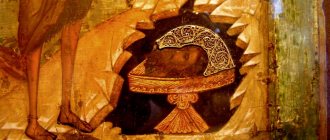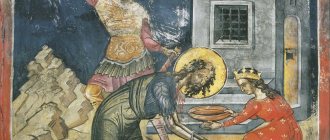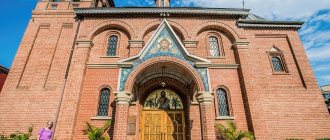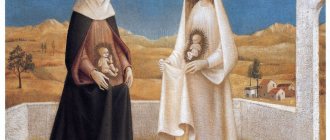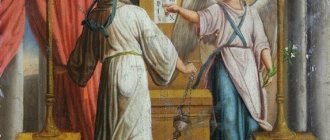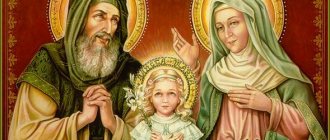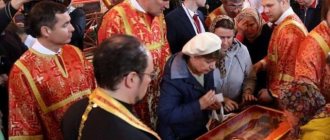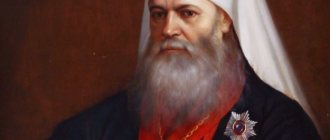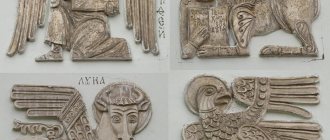| Honest head of St. Forerunner and Baptist of the Lord John. Icon |
The Honest Head of the Prophet and Forerunner of the Lord John,
Holy Tradition tells us that after the beheading of the honest head of St. John the Baptist, the wicked Herodias did not allow her to be buried along with the body of the saint, but, having violated her, buried her in her palace in a “dishonorable place.” The saint’s disciples secretly took the body and buried it. The pious Joanna, the wife of the royal steward Chuza (the holy evangelist Luke mentions her - Luke 8:3) knew where Herodias buried the honest head. And she secretly took the holy head, put it in a vessel and buried it on the Mount of Olives - in one of Herod’s estates.
When rumors about Jesus' preaching and the miracles he performed reached the royal palace, Herod and his wife Herodias went to check whether the head of John the Baptist was still there. Not finding her, they began to think that Jesus Christ is the risen John the Baptist. The Gospel also testifies to this error of theirs (Matthew 14:2).
Chapter of John the Baptist
Prophet John the Baptist is one of the most revered saints in Christianity. He was the last harbinger of the coming of Jesus Christ and therefore is called His Forerunner (translated from Old Slavonic - “one who walks ahead”). John also baptized the Savior in the Jordan River before the start of His public ministry. The head of John the Baptist is revered by Christians as a great shrine. After all, the Church teaches that the relics (remains) of the righteous are receptacles of Divine grace, which the saints acquired during their lifetime:
“God dwells in these bones. By him [God] they perform all miracles” (St. Ephraim the Syrian, Creations, volume 3).
Head of John the Baptist hidden in a cave
Meaning of Saint
John is one of the most famous and revered Christian saints. After all, it was he who baptized Jesus Christ. The celebration of the Council of John the Baptist on January 20 is directly related to this.
It is based on the custom of remembering the next day the saints who were directly related to the events that took place. That is why after baptism the Council of John the Baptist is celebrated.
The concept of “cathedral” in the name of the holiday means that people go to church and gather to perform a service in honor of the revered saint.
We give a fading orchid a chance: how to grow a new flower from a stump
Tested for generations: we make effective fertilizing for seedlings
Photo of asteroid 2001 FO32, which successfully flew past Earth
The role of John the Baptist is that it was he who testified to the coming of the Son of God to earth, completing the Old Testament history. It is with him that the emergence of new spiritual values, the era of the New Testament, is associated. Therefore, he is considered one of the greatest prophets.
The Life and Ministry of John the Baptist
Where are the relics of John the Baptist? First of all, you should familiarize yourself with his life. This prophet lived in the early 1st century AD in Ancient Israel. He was chosen by God for a special ministry even before he was born. An angel announced to the elderly childless priest Zechariah that he would have a son, who should be named John. The future prophet became a desert hermit in his youth. Away from people, through fasting and prayer, he prepared to fulfill his calling.
At the age of 30 (from this age, Hebrew men were considered spiritually mature for mentoring), John went out to the people and began to preach. He called on his compatriots to repentance and moral improvement, and also performed baptism on them in the Jordan River. With all this, John completed the preparation of the chosen people for the coming of the Savior, begun by the Old Testament prophets thousands of years ago. Baptism in the river symbolized cleansing from sins and was a prototype of the future Christian Baptism in which the spiritual rebirth of a person occurs. John the Baptist said:
“I baptize you with water, but one mightier than me is coming, whose sandal strap I am not worthy to untie; He will baptize you with the Holy Spirit and fire” (Luke 3:16).
On the eve of His sermon, Christ Himself received baptism from John. Thus, the sinless Lord showed the greatest humility and showed how important it is to fulfill the instructions of the Almighty. The Prophet John became the first person to publicly acknowledge Jesus as the Son of God and the long-awaited Redeemer of the sins of mankind. Also, during baptism, the Holy Spirit visibly descended on Christ in the form of a dove, and the voice of God the Father was heard from heaven:
“This is my beloved Son, in whom I am well pleased” (Matthew 3:16).
Thus, by performing baptism over the Lord, the prophet John became a participant in the first appearance of the Holy Trinity in the history of the world.
Honestly
On September 11, the Orthodox Church celebrated an event that is listed on the calendar as the Beheading of John the Baptist. On this day, the Church recalled the event when the last prophet of the Old Testament and the first prophet of the New Testament - St. John the Baptist (Forerunner) - was beheaded by order of the Tetrarch of Galilee, King Herod Antipas
From Herodias to Herod
I would like to start our article today from the end. Or, more precisely, from the events and circumstances of the execution of the holy prophet itself. And then we will talk about him and his most amazing and unique mission before the coming of the Messiah and Savior Jesus Christ.
Let us say right away that the Church honors John the Baptist above all saints after the Virgin Mary. John the Baptist is also called the Forerunner. Literally, “forerunner” means “predecessor.” Walking ahead. John is the one who came preaching about the Savior, before the Savior Himself.
The martyrdom of John the Baptist occurred in the year 32 of the 1st century. The evangelists Matthew and Mark talk about it in the New Testament of the Bible. This is how the Gospel of Mark tells about this event (6:17-29):
“Herod sent and took John and put him in prison for Herodias, the wife of his brother Philip, because he had married her.
For John said to Herod: You must not have your brother’s wife. Herodias, angry at him, wanted to kill him; but she couldn't. For Herod feared John, knowing that he was a righteous and holy man, and took care of him; I did a lot by obeying him, and listened to him with pleasure.
An opportune day came when Herod, on the occasion of his birthday, was holding a feast for his nobles, the captains of thousands and the elders of Galilee - the daughter of Herodias came in, danced and pleased Herod and those who were reclining with him; the king said to the girl: ask me what you want, and I will give it to you; and he swore to her: whatever you ask of me, I will give it to you, even up to half of my kingdom.
She went out and asked her mother: what to ask? She answered: the heads of John the Baptist. And she immediately went with haste to the king and asked, saying: I want you to give me now the head of John the Baptist on a platter.
The king was saddened, but for the sake of the oath and those reclining with him, he did not want to refuse her. And immediately, sending a squire, the king ordered his head to be brought. He went and cut off his head in prison, and brought his head on a platter, and gave it to the maiden, and the maiden gave it to her mother.
When his disciples heard it, they came and took his body and laid it in a tomb.”
Let us note that all this happened shortly before the Crucifixion and Resurrection of Christ.
So what exactly did John the Baptist do to Herod? After all, the people of Israel loved and revered him. John called for repentance. But not only. He also exposed sins.
Who was this Herod Antipas, on whose orders John the Baptist was beheaded? After the death of Herod the Great (the same one during whom the “slaughter of the infants” took place and during whom Jesus was born on earth), the Romans divided the territory of Palestine into four parts and installed their own protege as ruler in each part. Herod Antipas received control of Galilee from Emperor Augustus. Herod Antipas is called a tetrarch or tetrarch, because. he received a quarter of the land for management.
Antipas had a legitimate wife, the daughter of the Arabian king Arethas. Herod left her and cohabited with Herodias, his brother’s wife. The Prophet John the Baptist repeatedly denounced him, but the king did not dare to harm him, since he revered John the Baptist as a prophet and was afraid of the people's anger. Nevertheless, Saint John the Baptist was put in prison by King Herod Antipas.
On his birthday, Herod arranged a rich feast, at which Salome, the daughter of Herodias, danced in front of the guests. She pleased Herod so much that he swore before the guests to give her whatever she asked. Salome went to her mother for advice. Herodias taught her daughter to ask for the head of St. John the Baptist. Herod was saddened: he feared the wrath of God for killing the prophet, but could not break his careless oath.
John the Baptist's head was cut off and given to Salome. According to legend, the head continued to denounce Herod and Herodias.
The Church has preserved the tradition of what subsequently happened to Herod, Herodias and Salome. So, the head of John the Baptist continued to denounce... The frantic Herodias pierced the prophet’s tongue with a pin and buried the head in an unclean place. But Joanna, the wife of the royal steward Khuza, secretly took the holy head, put it in a vessel and buried it on the Mount of Olives, in one of Herod’s estates. The body of Saint John the Baptist, as already said, was taken by his disciples and buried.
God's wrath fell on those who decided to destroy the prophet. Salome crossed the Sycoris River in winter and fell through the ice. She hung with her body in the water, and her head was above the ice. Just as she had once danced with her feet on the ground, now she, as if dancing, made helpless movements in the icy water. She hung like that until the sharp ice cut her neck. Her head, cut off by a sharp ice floe, was brought to Herod and Herodias, just as the head of John the Baptist had once been brought to them, but her body was never found.
The Arabian king Arefa, in revenge for the dishonor of his daughter - the legitimate wife of Herod Antipas the Tetrarch - moved his troops against the wicked king and defeated him. The Roman emperor Gaius Julius Caesar Caligula (37-41) in anger exiled Herod along with Herodias to prison in Gaul, and then to Spain. There they were swallowed up by the opening of the earth.
The boy said - the boy did it?
So, on this day, the great prophet, righteous man and preacher, very revered by the people, was deprived of his life. Moreover, his life was cut short due to a combination of seemingly absurd circumstances: Salome, the daughter of Herod’s illegitimate wife Herodias, demanded the head of the Baptist on a platter as a reward for dancing at a feast...
Here are three people - Herod Antipas, Herodias, Salome. All of them were responsible for his death. But everyone had the opportunity to prevent this death. And not one did. Which of them is more to blame? This is how the regular interlocutors of the Orthodox portal “Pravmir”, Bishop Jonah of Obukhovskaya and Archpriest Alexander (Avdyugin), answered this question.
Bishop Jonah (Cherepanov): Any holiday of the Orthodox Church is always deeply edifying for an Orthodox person striving for spiritual growth, for perfection. There is also much that is instructive in the situation that occurred many years ago in Herod’s palace.
What should you take from this event? For example, that it is often better to sacrifice your reputation - or business, or anything else, but remain faithful to Christ. Still, often people, when faced with a decisive choice—whether they are with Christ or with a world that lies in evil—either out of cowardice or due to inertia, choose peace. There are many similar cases, and probably every person has encountered a similar situation.
We know that Herod treated John the Baptist with great respect and always listened to him with great attention. However, intoxicated, he was so carried away by the dance of Herodias’s daughter Salome that he promised her as a reward whatever she wanted, even up to half her kingdom. The young girl went to her mother, and she persuaded her to ask for the head of John the Baptist on a platter.
When Herod heard such a “request,” I think he instantly sobered up and came to his senses, but... He acted “purely like a boy”: “the boy said, the boy did.” He did not renounce his words for the sake of his pride and royal reputation, and as a result, he killed the righteous man, about whom Christ Himself said: “There was no man higher than those born to women.”
Indeed, what can people do to please public opinion, to please those around them whose opinions they value, even if these people have nothing to do with the faith or the Church, but are simply next to them.
So it is in this situation: we must not condemn Herod once again, saying that he acted this way and that. This holiday is for the edification of all of us. This is a reason to think: are we ready to sacrifice our reputation for the sake of Christ? And how many times in our lives have we sacrificed our faith for the sake of public opinion...
Which of the three is more to blame? I think it's all the same. But more than that, the sin that united them together is to blame. This sin first united Herod and Herodias in illegal cohabitation, and then was continued at the feast through the act of Salome.
This always happens: having stumbled once and having no desire to change, continuing to live a sinful life, persisting in his error, a person comes to the point where he commits an even greater sin.
Archpriest Alexander Avdyugin: The pride of Herod and the lust-based anger of Herodias gave rise to something that the daughter, Salome, did not care what to ask, just to fulfill her mother’s desire. Where the connection is based on sin, on the suffering of another, nothing good can grow. Probably no one has ever shown or told her what sin is and that the highest thing in the world is the image of God - man.
The blame lies with both Herod and Herodias. And this combination, one might say, of male and female sin in high society, based on untruth, on wealth, on power, on a riot of passions, will certainly give rise to such performers as Salome, who will also be limitless in their sin. For the sake of any desire, they agree to commit any crime, any sin.
What can be the conclusion? Any wrongly acquired wealth, any wrongly acquired position (no matter small or large) will lead to progressively increasing sin. The higher you rise, the harder it will be to throw it off, and the more you will sin. Many examples can be given. The only way out here is to stop.
Sin implies an ever-increasing gap between a person’s internal state and his external actions. What could this lead to today? A person becomes absolutely two-faced: he can have an excellent education, behavior, manners, but inside he is rotten, capable of any act, any nasty thing that is generally incompatible with the concept of man as the image of God.
And here is what Saint Luke (Voino-Yasenetsky) wrote: “The most shameful stain in the history of mankind was the day on which the most holy head of John the Baptist and Baptist of the Lord, the greatest of those born of women, fell under the sword of the executioner, according to the word of our Lord Jesus Christ. His head fell and was brought to the devil’s feast, and was given to the dancing maiden, and she took it to her mother, the devil’s disciple, Herodias. And the devil himself enjoyed the spectacle of how this accursed disciple of his, with an evil grin, pricked the tongue of the severed head of the Forerunner with a needle.”
In general, that day - the day of the cruel reprisal against the prophet - was a day of great sin and great sorrow.
Herodias hated the Baptist, who denounced her lawless alliance with Herod. She looked for any way to destroy John the Baptist and “went berserk,” as is sung about in the hymns of the Church.
And this day is celebrated as an All-Night Vigil: believers spend the day in prayer, trying to drive away irritation and anger towards their neighbor from their hearts.
Herodias' daughter Salome performed such a shameless dance that Herod's consciousness darkened, and he threw everything at her feet - any of her wishes would be fulfilled! And believers exclude noisy fun from their lives on this day; the Sacrament of Wedding is not performed on this day.
The tables were bursting with exquisite meat dishes, the cups were full of wine, the mind was clouded, and in the noise of the feast the words of Salome rang: “Give me the head of John the Baptist on a platter.”
In the Church, this day is a strict fast; meat, dairy products, and fish are not eaten. The purpose of a one-day fast on this day is to remind people of the terrible consequences that the passion of intemperance leads to.
“We will not be accomplices of Herod’s gluttony,” the Typikon (church charter) reminds us. – How can we honor the Beheading of the Baptist? Shall we eat meat or other delicious food? But the Baptist lived in a waterless and grassless desert - he ate neither bread nor had any other food. Do we drink wine? But he did not drink wine or any other worldly drink. His table and bed were the earth, he ate only locusts (the pods of the carob tree, according to other sources - a type of edible locust) and wild honey. Instead of a bowl, there are handfuls of water flowing from a stone. Therefore, let us spend this day in fasting and prayer."
But the real meaning of this day and the labors that believers undertake is often forgotten: superstitions are spreading among the people. So in our newspaper in the last issue on the second page in the “people's calendar” there was a phrase that on September 11 “it is forbidden to eat everything round, cook cabbage soup, chop cabbage, cut poppy seeds.” There are also widespread beliefs that chopping and cutting objects should not be used on this day. All these superstitions have no basis in the traditions of the Church; they do not need to be given any importance, and, moreover, they do not need to be followed.
"His name is John"
So who was John the Baptist? Even the holy Old Testament prophet Malachi predicted that before the Messiah (i.e. Christ) His Forerunner would appear, who would indicate His coming. Therefore, the Jews, who were expecting the Messiah, were also waiting for the appearance of His Forerunner.
“Behold, I send My angel, and he will prepare the way before Me, and suddenly the Lord, whom you seek, and the Angel of the covenant, whom you desire, will come to His temple” (Malachi 3:1).
The angel who will prepare the way for the Lord is the Forerunner of the Lord, predicted by Isaiah as “the voice of one crying in the wilderness” (Isaiah 40).
In the words: “Behold, I will send Elijah the prophet to you before the coming of the great and terrible day of the Lord. And he will turn the hearts of the fathers to the children, and the hearts of the children to their fathers, lest I come and smite the earth with a curse” (Malachi 4:5-6), the prophet Malachi predicts the appearance of the messenger of the coming of the Lord.
It should be noted that in the minds of the post-exilic Jews and the prophet Malachi himself, the coming forerunner of the Messiah is a prophet whose activities will be similar to the historical Elijah the Tishbite. The mission of the coming Elijah (i.e. John the Baptist) is “preparing the way of the Lord” (Mal. 3:1), that is, the moral preparation of the people for the coming of the Messiah, “returning the hearts of the fathers to the children and the hearts of the children to their fathers,” so that the Lord does not completely destroy the sinful people, “he does not smite the earth with a curse” (Mal. 4:6).
This prophecy was fully and completely fulfilled by John the Baptist, who acted “in the spirit and power of Elijah” (Gospel of Luke 1:17) and prepared the people for the preaching of Christ, “baptizing with the baptism of repentance, telling the people that they should believe in Him who would come after him, is in Jesus" (Acts 19:4).
The book of the prophet Malachi ends the prophetic books, and at the same time all the canonical books of the Old Testament. The Old Testament prophecies end with what the Gospel begins - with the story of John the Baptist.
And so, in the city of Judah in the mountainous country of Palestine lived the righteous priest Zechariah and his wife Elizabeth, who immaculately kept the commandments of the Lord. However, the couple were unhappy: having lived to an advanced age, they were childless and did not stop praying to God to give them a child.
Zechariah and Archangel Gabriel
One day, when Saint Zechariah was yet another priest in the Temple of Jerusalem, he entered the Sanctuary during a service to burn incense. Entering the curtain of the Sanctuary, he saw the Angel of God standing on the right side of the incense altar. Saint Zechariah was embarrassed and stopped in fear, but the Angel said to him: “Do not be afraid, Zechariah, your prayer has been heard, your wife, Elizabeth, will bear you a son, and you will call his name John.”
But the righteous Zechariah did not believe the words of the Heavenly Messenger, and then the Angel said to him: “I am Gabriel, standing before God, and I was sent to bring this good news to you. And so, you will be dumb until your birthday, because you did not believe my words.” Meanwhile, the people were waiting for Zechariah and were surprised that he did not leave the Sanctuary for so long. And when he went out, he was supposed to give a blessing to the people, but he could not pronounce it, because he was struck dumb. When Zechariah explained by signs that he could not speak, the people realized that he had a vision. The prophecy of the Archangel was fulfilled, and righteous Elizabeth was freed from the bonds of infertility, giving birth to the world the Forerunner and Baptist of the Lord, John.
Saint Elizabeth conceived and, fearing ridicule for her late pregnancy, hid for five months until the Most Blessed Virgin Mary, who was her distant relative, visited her to share her and her joy. Elizabeth, filled with the Holy Spirit, was the first to greet the Virgin Mary as the Mother of God. Together with her, the Most Holy Virgin Mary and the Son of God incarnate in Her were also greeted by Saint John, who was still in the womb of his mother, the righteous Elizabeth. “When Elizabeth heard Mary’s greeting, the baby in her womb leaped; and Elizabeth was filled with the Holy Spirit” (Gospel of Luke 1:41).
The time came, and Saint Elizabeth gave birth to a son, all relatives and friends rejoiced with her. His mother named him John. Everyone was surprised, since no one in their family bore this name. When they asked Saint Zechariah about this, he asked for a tablet and wrote on it: “His name is John” - and immediately, according to the prediction of the Archangel, the bonds that bound his speech were resolved, and Saint Zechariah, filled with the Holy Spirit, glorified God and uttered prophetic words about the One who had appeared in the world Messiah and about his son John - the Forerunner of Jesus Christ.
Preparing people
By the grace of God, baby John escaped death among the thousands of murdered infants in and around Bethlehem. Saint John grew up in the wild desert, preparing himself for great service through a strict life of fasting and prayer. He wore rough clothes secured with a leather belt and ate wild honey and locusts (a genus of locust). He remained a desert dweller until God called him at the age of thirty to preach to the Jewish people.
Obeying this calling, the prophet John appeared on the banks of the Jordan River to prepare the people to receive the expected Messiah (Christ). Before the holiday of purification, people gathered in large numbers to the river for religious ablutions. Here John turned to them, preaching repentance and baptism for the remission of sins.
The essence of his preaching was that before receiving external washing, people must be morally cleansed, and thus prepare themselves to receive the Gospel. Of course, John's baptism was not yet the grace-filled sacrament of Christian Baptism. Its meaning was spiritual preparation for the future Baptism of water and the Holy Spirit.
According to the expression of one church prayer, the prophet John was a bright morning star, which in its brilliance surpassed the radiance of all other stars and foreshadowed the morning of a blessed day, illuminated by the spiritual Sun of Christ (Malachi 4:2). When the expectation of the Messiah reached its highest degree, the Savior of the world Himself, the Lord Jesus Christ, came to John to the Jordan to be baptized and immersed in water. The baptism of Christ was accompanied by miraculous phenomena - the descent of the Holy Spirit in the form of a dove and the voice of God the Father from heaven: “This is My beloved Son...”.
Having received a revelation about Jesus Christ, the prophet John told the people about Him: “Behold the Lamb of God, who takes away the sins of the world.” Hearing this, two of John's disciples joined Jesus Christ. These were the apostles John (the Theologian) and Andrew (the First-Called, brother of Simon Peter).
With the baptism of the Savior, the prophet John completed and, as it were, sealed his prophetic ministry. He fearlessly and strictly denounced the vices of both ordinary people and the powerful of this world. For this he soon suffered, as we described above.
Two baptisms
Baptism, in Greek "baptisma", means "immersion in water." The custom of water immersion itself is very ancient - much older than Christian baptism. The practice of ritual ablutions is found in many religions of the world.
Even in the Old Testament Church there was a practice of water immersion, although in it they had a completely different meaning than in the New Testament. According to the Old Testament, any Jew, after any desecration that happened to him, had to perform a special water ablution - a “mikvah”.
A completely new development and filling of Baptism in the New Testament was given by the holy prophet John the Baptist. Saint John the Baptist also baptized Jews in the waters of the Jordan; John's baptism and Christian Baptism are two different baptisms. John's baptism was a baptism of repentance, although it did not free a person from the source of all sins - original sin. Christian baptism gives forgiveness of all sins and renews a person.
The Baptism of John was a preparatory step for each person who received it for a personal meeting with Christ, for the acceptance of the Messiah expected by the Jews.
During John's baptism, a person, entering the water, confessed his sins, which is why it is called “baptism of repentance.” The only one who entered the water and did not linger in it was the sinless God-man Jesus Christ. John called on those who accepted his baptism to become pure, because among them was already standing the One who had come to redeem them and with whom they were about to meet. So, through the baptism of John, a person had to prepare for a meeting with Christ, Who had just come into the world, having entered into battle with Satan and sin. Christian baptism is the Baptism of the Holy Spirit; it gives absolutely new gifts, which are a consequence of the victory already won by Christ over the devil, resurrection with Christ, new life, new spiritual birth. The same baptism as John’s was the baptism of the apostles, performed by them even before the Resurrection of Christ.
Only after Pentecost - the descent of the Holy Spirit on the Church, which occurred shortly after the Ascension of Christ - does a new, Christian Baptism reveal itself in the New Testament Church. The book of the Acts of the Apostles quotes the words of the Lord, who Himself speaks about this: “John baptized with water, but a few days after this you will be baptized with the Holy Spirit” (Acts 1:5).
Prepared by Alexander OKONISHNIKOV, “WORD OF HONEST”
Click to support "Honestly"
Share
Martyrdom of John the Baptist
While preaching, the prophet John fearlessly denounced stubborn sinners, among whom was the ruler of Judea. Archimandrite Alipiy (Voronov) says:
“Herod, king of Judea, took the wife of his brother Philip, Herodias, as his wife. John the Baptist denounced Herod for this illegal cohabitation. The evil Herodias harbored a grudge against the prophet of God and, wanting to destroy him, influenced the king to imprison the Forerunner.”
Once, at a royal feast, the daughter of Herodias, Salome, danced in front of the ruler and his guests. The impressed king promised to fulfill the girl’s every whim in front of everyone. Herodias told her daughter to demand the execution of John, who was imprisoned. Herod did not want the prophet to die, but did not dare to break the oath given at the feast. By order of the king, the head of John the Baptist was beheaded, which was then brought to the queen on a platter.
Tradition says that the dead lips of the righteous man continued to expose the sins of Herodias. In a fit of anger, the queen mutilated John's head and then threw it away in an unclean place. The body of the prophet by that time had already been buried by his disciples. The Monk Justin (Popovich) notes:
“The Holy Forerunner appeared in the kingdom of death and as the first Evangelist to preach the Gospel of Christ to all souls in the kingdom of death. He appeared to all of them as the first martyr to show how for the True God, the Lord Jesus Christ, the Savior of the world, people will joyfully go to death until it is defeated and trampled under foot.”
Burial
The disciples buried his body. According to legend, the head continued, as before, to denounce Herodias and Herod. Fearing the resurrection of John, the authorities did not give up his head so that it could be buried next to the body.
Then the wife of the king's steward, Khuza, secretly buried her head on the Mount of Olives. Herod, not finding the head of the Baptist, believed that his resurrected accuser became Jesus Christ.
“There is only emptiness around...”: how to understand that your soul is tired (and not your body)
Bringing the rose bush back to life after winter: how to properly reanimate flowers
The craftswoman showed what beauty she makes from egg trays: there’s no shame in giving as a gift
Head of John the Baptist: history of discovery
Many church holidays have been established in honor of John the Baptist. Some glorify the milestones of his earthly life (Conception, Nativity, Beheading of John the Baptist). Others remind Christians of significant events associated with the holy relics of the prophet. For example, there are holidays in honor of the three miraculous acquisitions of his head.
Since ancient times, the head of John has been a particularly revered shrine, because this prophet is considered by the Church as the greatest of all saints (after the Mother of God). Standing on the border of two Testaments, John became the last preparer of people for salvation in Christ. The Savior Himself said:
“Among those born of women there has not arisen a greater one than John the Baptist” (Matthew 11:11).
The head of John the Baptist is also a symbol of his steadfastness and martyrdom in the service of the Truth. The Church considers the three miraculous discoveries of this relic as a threefold victory of holiness and truth over evil and death.
According to legend, the head of John the Baptist, discarded by Herodias, was reverently buried by a secret Christian woman who was among those close to Herod. In the 4th century, a rich Christian began construction of a temple on the burial grounds of the shrine. During the work, the head of the prophet was found for the first time. The event was accompanied by miraculous signs.
After some time, the relic ended up in Syria, where it was lost again. According to God's Providence, a monastic monastery was erected on the site of the secret residence of the head. Already in the middle of the 5th century, the second miraculous discovery of the shrine took place - John the Baptist appeared to the abbot of the monastery and indicated its location. The first and second finding of the head are celebrated by the Church on March 9 (March 8 in a leap year).
The shrine was transported to Constantinople, and then, during the iconoclastic persecutions, to the city of Comana. There the head of the prophet was again lost. In the mid-9th century, the location of the relic was revealed to Patriarch Ignatius in a miraculous vision. With the participation of the Byzantine emperor, it was found for the third time and solemnly transferred to Constantinople. This event is celebrated by the Church on June 7.
Head of John the Baptist in modern times
The head of John the Baptist - where is it today? In the Middle Ages, the shrine was repeatedly divided into fragments, which were scattered across many countries. Today, Christian temples and mosques (John is revered in Islam as the prophet Yahya) in Italy (Rome), France (Amiens), Syria (Damascus), Turkey (Antioch), Greece (Athos) and Nagorno-Karabakh claim ownership of pieces of the head.
In the mid-20th century, research was carried out on a fragment of the chapter (front part), which has been kept in the cathedral of the French city of Amiens for 800 years. A commission of scientific experts declared a high probability of the authenticity of the shrine. Let us quote the words of the priest-historian Timothy Katnis:
“If we are talking about the most likely location of the shrine, then this is, of course, the Cathedral of Notre Dame in France. Of all the places [where the chapter is supposedly kept], only here has a large and high-quality study of the shrine been carried out, and it is also known that this particular part of the chapter has a clear historical path.”
It is noteworthy that there is a small hole above the left eye socket of the Amiens chapter fragment. This is probably the mark of a dagger blow that Herodias struck in a fit of rage. It is known that French kings made pilgrimages to the shrine. She is also credited with saving the city from the plague in the 17th century. In the same century, Saint Demetrius of Rostov testified about the visit of Amiens by Orthodox pilgrims. Priest Maxim Massalitin notes:
“In recent years, Orthodox pilgrims have been visiting Amiens more and more often. With the participation of the Pilgrimage Center of the Korsun Diocese, Orthodox prayer services and liturgies are performed at the head of St. John the Baptist.”
Prayers to John the Baptist on the holidays of the finding of his head
On the first and second finding of the head of John the Baptist:
Troparion, tone 4
Having risen from the earth, the Forerunner's head sends forth rays of incorruption to the faithful, gathering from above a multitude of Angels, and then convenes the human race unanimously to send glory to Christ God.
Kontakion, tone 6
Prophet of God and Forerunner of grace, your head, like a most sacred thorn, having found from the earth, healing is always acceptable, for again, as before, you preach repentance in the world.
On the third discovery of the head of John the Baptist:
Troparion, tone 4
Like a Divine treasure hidden in the earth, Christ opened your head to us, prophet and Forerunner. All of us, having come together in this finding, let us sing the Savior’s hymns of God, saving us from corruption through your prayers.
Kontakion, tone 6
The luminous and Divine pillar in the world, the lamp of the sun, the Forerunner, showing his luminous and Divine head at the end, sanctifies those who faithfully worship and cry: O wise Christ to the Baptist, save us all.
Greatness for both holidays
We magnify you, John the Baptist of the Savior, and honor all your honorable achievements.
Prayer to the Prophet John the Baptist
Baptist of Christ, honest Forerunner, extreme prophet, first martyr, mentor of fasters and hermits, teacher of purity and neighbor of Christ! I pray to you, and when you come running, do not reject me from your intercession, do not forsake me, who have fallen through many sins; renew my soul with repentance, like a second baptism; Cleanse me, the sins of the defiled, and compel me to enter into the Kingdom of Heaven, even if nothing bad enters. Amen.
Read us conveniently on social networks:
Tags: head of John the Baptist, head of John the Baptist, where is the head of John the Baptist, relics of John the Baptist, beheading of John the Baptist, beheading of John the Baptist
